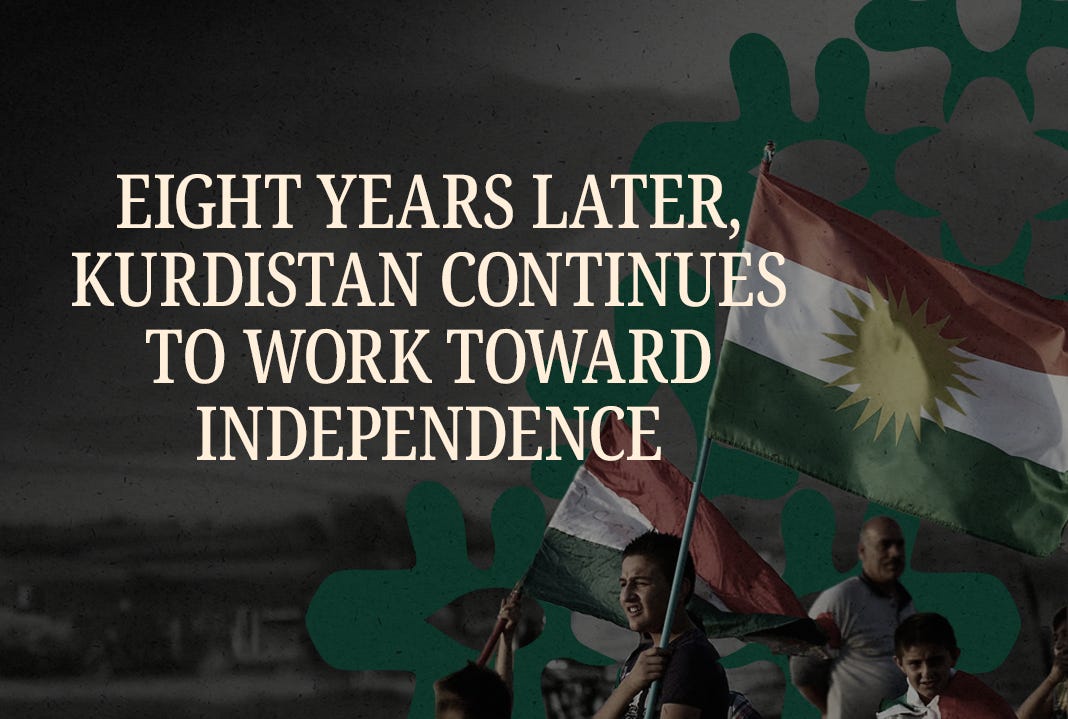Eight Years Later, Kurdistan Continues to Work Toward Independence
Kurdistan has shifted from chasing statehood to fortifying its economy and governance, positioning itself as one of the Middle East’s rare zones of stability.
The September 25, 2017, independence referendum redrew the trajectory for the Kurdistan Region of Iraq (KRI). Located in northern Iraq, the KRI is a self-governing area recognized by Iraq’s constitution, known for its distinct Kurdish identity, elected parliament, and relative stability compared to the rest of the country. More than 92 percent of voters endorsed independence, clearly illustrating decades of Kurdish aspirations for statehood. But instead of paving the way for sovereignty, the referendum triggered political backlash, military losses, and economic hardship that forced the Kurdistan Regional Government (KRG) to shift its focus from the dream of independence to the urgent demands of stability, governance, and economic reform.
In the weeks following the vote, the federal government in Baghdad—backed by Turkey, Iran, and much of the international community—rejected the results outright, with the Iraqi government calling it “illegal.” Iraqi forces recaptured disputed territories, including oil-rich Kirkuk, a vital source of KRG revenue. Border controls were tightened, international flights to Erbil and Sulaimania were suspended, and the KRI found itself increasingly isolated.
The loss of Kirkuk’s oil income deepened a financial crisis already aggravated by the 2014 oil price crash and budget disputes with Baghdad. Public sector salaries went unpaid for months, unemployment surged, and confidence in the KRG’s ability to deliver independence waned.
Faced with a crisis, the KRG redirected its efforts away from immediate statehood toward economic stabilization and rebuilding relations with the central government in Baghdad. Under then-Prime Minister Nechirvan Barzani, the government engaged in sustained dialogue with federal authorities, securing the partial restoration of budget transfers and the reopening of airports.
Building on that foundation, the current cabinet has placed greater emphasis on development and modernization. The government is working to strengthen institutions, attract investment, and diversify the economy by focusing on agriculture, tourism, infrastructure, and foreign partnerships.
Infrastructure and institutional reform have become central to the KRG’s post-referendum strategy. Efforts include upgrading electricity generation, improving road networks, and expanding digital services. Legal and regulatory frameworks, such as the Kurdistan is Open for Business initiative, are being updated to attract investment, reduce bureaucratic delays, and replace outdated business laws.
Several major initiatives are now underway:
Runaki Project: Aims to deliver uninterrupted electricity to all citizens and businesses by 2026.
KRDPass: A mobile app giving citizens access to government services online.
MyAccount: A financial inclusion program for public employees, with over 465,000 accounts opened as of September 2025.
Business Registration System: A centralized online platform that simplifies company formation and reduces red tape.
Advanced Data Center: A Tier III certified facility designed to securely host government services and protect data.
Water security has also become a strategic priority, with the completion of four new dams and construction underway on 13 more. Plans for four large dams, including the billion-cubic-meter Mandawa Dam, are intended to tackle chronic water shortages and strengthen resource management.
The KRG has sought to attract foreign investment by amending its investment law to guarantee equal treatment for domestic and foreign investors. Incentives now include tax exemptions, land allocations, and the ability to repatriate capital freely. The launch of the Invest Kurdistan platform showcases opportunities across multiple sectors to international investors.
So far, the government has licensed more than 1,350 projects worth $72 billion, including $12 billion in foreign direct investment and joint ventures. Landmark energy agreements with U.S.-based companies HKN Energy and Western Zagros are expected to expand the region’s energy infrastructure and encourage further international engagement.
For Kurdish policymakers, the 2017 referendum remains both a cautionary tale and a driver of new strategy. It exposed the geopolitical limits of unilateral action while highlighting the urgent need to fortify the region’s economy and institutions before seeking independence again.
Today, KRI’s leadership is focused on building a viable future by strengthening governance, modernizing infrastructure, and attracting international investment. The KRI is a crucial hedge against instability in a region characterized by protracted conflict, failing states, and the resurgence of extremist movements.
From Gaza to Syria to Yemen, the Middle East is convulsed by war and sectarian divisions. In that context, the KRI’s relative stability and openness to international partnerships make it one of the places where progress seems within reach. A stronger KRI represents a buffer against extremism, a partner for Western governments, and a potential model of pluralism and development in a volatile neighborhood.
The choices Kurdish leaders make now will determine whether the region can translate its hard-won autonomy into lasting security and prosperity or risk being pulled back into the cycle of conflict that surrounds it. Independence may still lie on the horizon, but the groundwork being laid today could decide whether Kurdistan will be ready when the opportunity comes.
Middle East Uncovered is powered by Ideas Beyond Borders. The views expressed in Middle East Uncovered are those of the authors and do not necessarily reflect the views of Ideas Beyond Borders.




